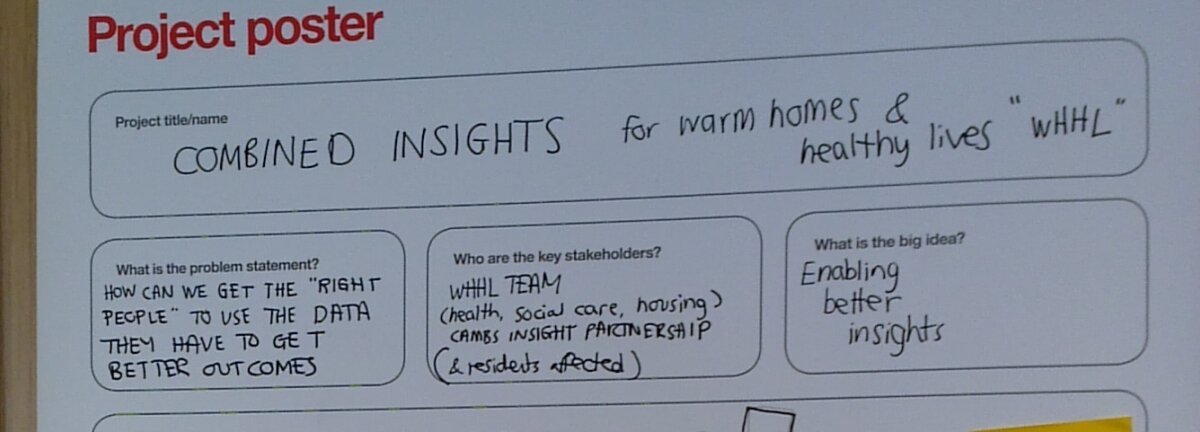Design in the Public Sector: Cambridgeshire Council’s insights – Part I

Design Council’s Design in the Public Sector programme increases the knowledge and use of strategic design skills across local authority public services, exposing teams to new ways of working and enabling them to do something practical to meet their challenges in a relatively short period of time.
Here Hendrik Grothuis, Research Manager at Cambridgeshire County Council, outlines his experience of the programme so far.
The ‘why’
We attended the Design in the Public Sector (DiPS) programme with some trepidation. After all we were data people, not design specialists. Our team is a bunch of research, data, technology and digital folks.
First of all, it is always great to see what peers in the east of England are doing and I am always astonished by the breadth of projects that colleagues are undertaking. We had transport, health, social care and community projects included, among others, all in the same room.
Our problem is both simple and complex. We need data to support service transformation and are looking to take a design-based approach to solve problems for local partners. This work includes a wide scope, from digital transformation to data transformation and how this impacts service and partnership work.
The workshops
The interactivity of the two design programme days allowed us to refine what we were undertaking from a broad project to something more tangible.
I was really pleased with how Design Council presented their framework and tools to allow us to start our journey of design-led thinking. They were easily understandable but also engaged new ideas in a way that would not work with more traditional project management approaches.
With proper consideration, we designed an inventory of the participants for the project - both active and passive - which allowed us to develop a practical thought process to create a tangible, and most importantly achievable, project. And hey, we even have a roadmap with, some very rough, timelines now.
Doing a proper elevator pitch for a project is always challenging and this was no exception. However, using the design-centred tools that we were presented with allowed us to scope and scale this project in a design-thought manner that gave structure, responsibility and most importantly achievability (if that is a thing?) to a challenging idea.
Putting our initial project of (warning: reading this is a bit of a mouthful) ‘acting as the data enabler for the organisation outcomes and work with representatives from local partnerships to assist with co-creating and distributing data led solutions’ through a design lens shortened both the title of the project and also refined the goal of it. It is now ‘Combined Insights for fuel poverty’. More concise, definitely more targeted and again, has that achievability factor.
The next steps
We’ve got a lot to do for the next DiPS session in September, beginning with the fact that we need to know more about the projects we are attempting to influence. We’re on our way to observing the needs and demands of the participants and preparing any easily available resources (data, research and visualisations - see below) so that they can be used to inform the initial stages of preparation. Or to try and be concise again, we need to POD it (Prepare-Observe-Design).
The resources
We’re doing some things already that are a good starting point for the DiPS programme. We have a research website, Cambridgeshire Insight, to share best practice and local research to feed the process of evidence-led policy, and we are in the process of developing our open data portal - Cambridgeshire Insight Open Data.
As a result of the two days, we have redesigned our thinking to allow a ‘Combined Insights’ project that would benefit from using some of our developed resources in a smarter way. The resources needed to jumpstart the analysis, while the visualisation and reporting tools for the ‘Combined Insights’ project include work that has already been completed for additional projects. They include:
- Fuel poverty Open Data and data visualisation
- Deprivation open data, especially IDAOPI: Income Deprivation Affecting Older People and data visualisation
- Health - Cambridgeshire Atlas Census 2011: Overview of health and unpaid care
- Social classification - Cambridgeshire Output Area Classification 2011 - Data visualisation and open data
The DiPS programme so far has been a great mechanism to allow us to get beyond the culture of individual pieces of work and start to integrate a design-led data approach as part of our day-to-day working practices.
Time will tell how we get on…
The second stage of the Design in the Public Sector programme takes place in September. Hendrik will continue to blog about Cambridgeshire County Council’s experience and you can keep up to date here.
Subscribe to our newsletter
Want to keep up with the latest from the Design Council?
